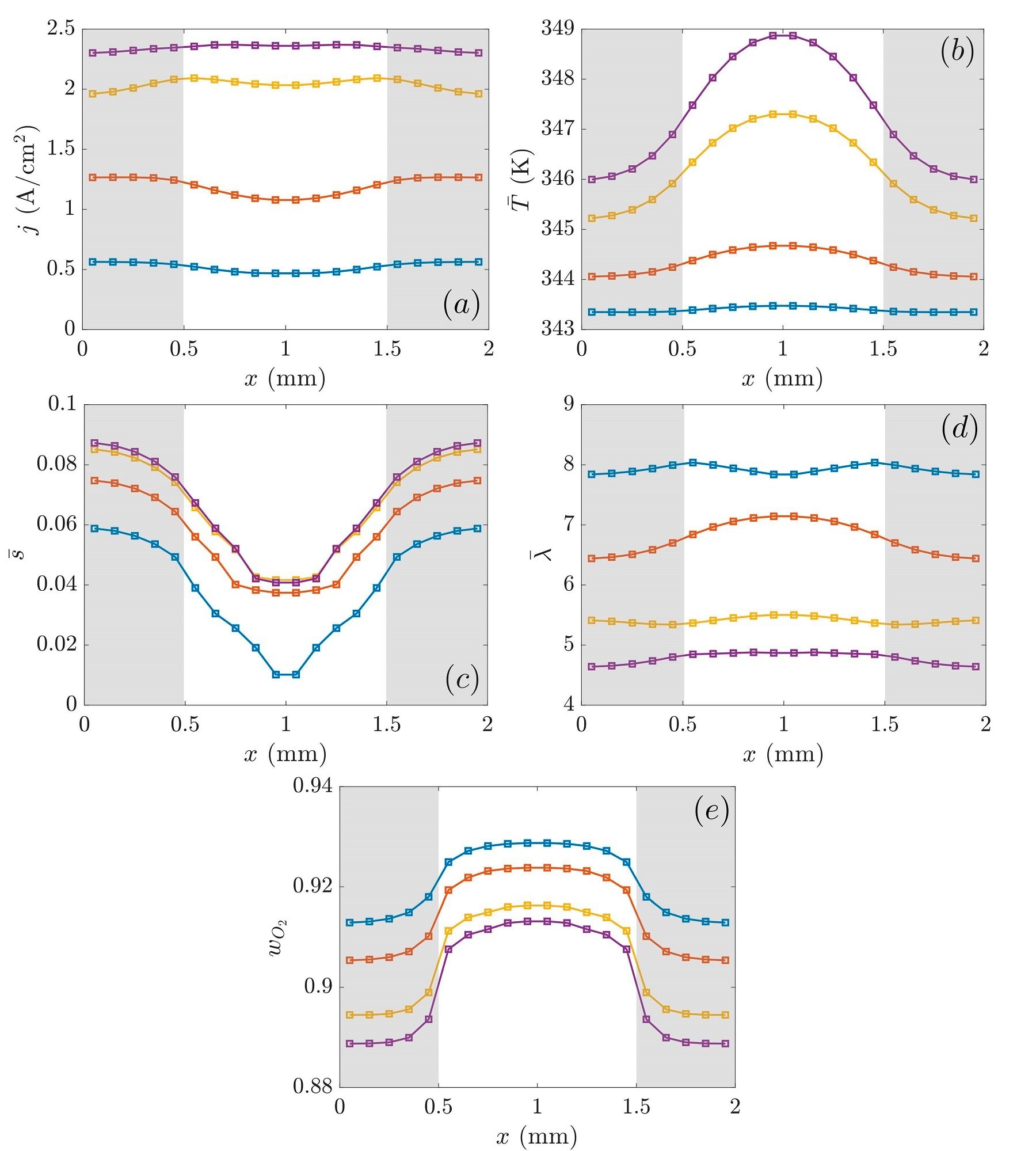Recent research has aimed to obtain a better understanding of the complex and tightly coupled interactions that occur inside a fuel cell, relating water generation and transport to local temperature distributions and cell performance, with a focus on the under-rib and under-channel features.

yz− weighted average of current density (a), temperature (b), and water content (d) across the membrane. Averaged water saturation (c) is reported in between GDLs and membranes. Subplot (e) describes the oxygen concentration average in the GDLc/channel/rib interface. Shaded areas represent half-rib zones. The operating temperature is T0 = 343 K and the reactants relative humidity is 90%. Image Credit: University of Seville
Proton-Exchange Membrane Fuel Cells (PEMFCs), which transform fuel into electric energy via a solid electrolyte membrane, have emerged as one of the most promising devices for the electrical conversion of hydrogen.
A group of researchers from the University of Seville’s Department of Energy Engineering collaborated with AICIA (the Association for Research and Industrial Cooperation of Andalusia) to run three-dimensional CFD simulations to explore the role of water in the performance of a single straight-channel PEMFC at various operating temperatures.
The research attempted to gain a better understanding of the complex and tightly coupled interactions that occur inside the fuel cell, relating water generation and transport to local temperature distributions and cell performance, with a focus on the under-rib and under-channel features.
A sensitivity analysis showed that for the operating temperatures in their research (70–90 ºC), the higher the operating temperature, the stronger the electrical performance of the PEMFC, as long as the reactants’ relative humidity is kept at a high value. Despite operating at high current densities (j = 2.25 and 2.57 A/cm2), the enhancement of water diffusivity and electro-osmotic drag resulted in an increase in ionic conductivity.
Despite the decline in water saturation and membrane hydration levels, cross-sectional averages indicated that evaporation effects are not significant enough to reduce PEMFC performance under such operating conditions.
Temperature profile plots in dimensionless form, on the other hand, have shown some similarities that may be useful for the characterization or design of PEMFCs using analytical expressions or scaling laws.
Regarding the oxidizer, it has been discovered that the distributions of oxygen consumption look very similar across all operating temperatures, with the highest values found under channel and the lowest under rib, and a clear decrease in oxygen concentration as the load increases.
Despite an exhaustive sensitivity study, the investigators claimed that isolating a single variable from the rest of the variables in a PEMFC is not always possible due to the diverse nature and coupling of the mechanisms involved.
The research was supported by Grant PY20 RE 315 026 AICIA funded by S.G. de Universidades, Investigación y Tecnología, PAIDI 2020 program 316 by Junta de Andalucía, co-funded with ERDF funds. Grant PID2019–104441RBI00 funded by 317 MCIN/AEI/10.13039/501100011033, co-funded with ERDF funds.
Journal Reference
Martín-Alcántara, A., et al. (2023) New insights into the temperature-water transport-performance relationship in PEM fuel cells. International Journal of Hydrogen Energy. doi.org/10.1016/j.ijhydene.2022.12.281.